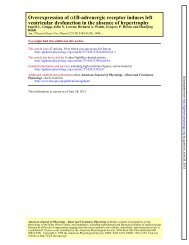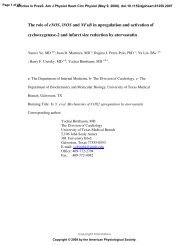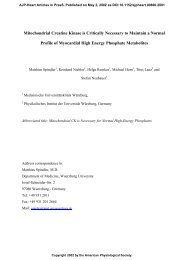1 Mariannick Marcil, Karine Bourduas, Alexis Ascah, Yan Burelle ...
1 Mariannick Marcil, Karine Bourduas, Alexis Ascah, Yan Burelle ...
1 Mariannick Marcil, Karine Bourduas, Alexis Ascah, Yan Burelle ...
You also want an ePaper? Increase the reach of your titles
YUMPU automatically turns print PDFs into web optimized ePapers that Google loves.
Indeed changes in the expression of cyclophilin-D are known to translate in an altered potency<br />
of CsA at inhibiting Ca 2+ -induced PTP opening (3, 4, 45, 52).<br />
Our results also indicate that in contrast to what was observed with succinate, no<br />
significant difference between C and T groups was observed for CRC in presence of complex I<br />
substrates. As mentioned above, PTP opening is strongly regulated by electron flow through<br />
complex I, which sensitizes mitochondria to permeability transition (6, 22, 40). Our data thus<br />
indicate that training did not protect against this sensitizing effect. In contrast when complex I<br />
was bypassed a protective effect of training, probably through other regulators of PTP opening,<br />
was unmasked.<br />
Effect of training on physiological modulators of PTP opening:<br />
To our knowledge, there is no data available in the literature concerning the effect of<br />
training on parameters involved in the regulation of the PTP in the heart. In the present study,<br />
we therefore determined whether the training-induced increase in the resistance to Ca 2+ -induced<br />
PTP opening observed with complex II substrates was accompanied by changes in selected<br />
physiological modulators of PTP gating and/or in mitochondrial respiratory activity.<br />
Ca 2+ -induced permeability transition is modulated by a variety of physiological effectors.<br />
The occurrence of PTP opening at a given Ca 2+ load is reduced when membrane potential is<br />
increased due to the fact that the PTP behaves as a voltage-gated channel sensitive to changes<br />
in over a range of 180 – 120 mV (7). Matrix adenine nucleotides are also potent inhibitors of<br />
PTP opening, with ADP exerting a stronger inhibitory effect than ATP (60) (16). Maintenance of<br />
the PN pool at a high reduction state is another factor known to decrease PTP opening induced<br />
by Ca 2+ and Pi probably through mechanisms involving direct interaction of PN’s with the PTP<br />
and to oxidation of critical SH residues of pore-forming proteins (6, 60). Low levels of ROS<br />
16






